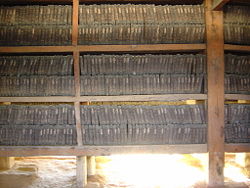Tripitaka Koreana
The Tripitaka Koreana (lit. Goryeo Tripitaka) or Palman Daejanggyeong ("Eighty-Thousand Tripitaka") is a Korean collection of the Tripitaka (Buddhist scriptures, and the Sanskrit word for "three baskets")stored in Haeinsa, a Buddhist temple in South Gyeongsang province, in South Korea.
Carved onto 81,340 wooden printing blocks in the 13th century, Buddhist scholars consider the Tripitaka Koreana the best preserved and most complete version of Buddhist canon in Chinese script. With 1496 titles in 6568 volumes comprising 52,382,960 characters, the Tripitaka Koreana has no known copy errors. Each wood block measures 70 centimeters in width and 24 centimeters in length. The thickness of the blocks range from 2.6 to 4 centimeters and each weights about three to four kilograms.
Tripitaka Koreana, also known as the "Goryeo Tripitaka" the name "Goryeo", the name for Korea during the 10th century to the 14th centuries served as source for the edition of the Taisho Shinshu Daizokyo.
Korean Buddhist scholars first carved the Tripitaka Koreana in 1087 when the Khitan invaded Goryeo during in the Third Goryeo-Khitan War. The King commissioned the carving the woodblocks to evoke the protection of Buddha in the face the Khitan's invation.
During the Mongol invasions of Korea in 1232, the Mongols destroyed the original set of woodblocks. When capital Goryeo moved to Ganghwa Island during nearly three decades of Mongol attacks, King Gojong of Goryeo ordered the recarving of the Tripitaka. The carving took 16 years, from 1236 to 1251. At the beginning of the Yi Dynasty in 1398, the court moved the second copy to Haeinsa where they have remained housed in the Haeinsa library, Janggyeong Panjeon (National Treasure No.52).
The Tripitaka Koreana is the 32nd national treasure of Korea, and the Haeinsa Temple Janggyeong Panjeon, the depository for Tripitaka Koreana, has been designated as a UNESCO World Heritage Site. The UNESCO committee describes the Triptaka Koreana as one of the "most important and most complete corpus of Buddhist doctrinal texts in the world." Not only is the work invaluable, it is also aesthetically valuable and shows a high quality of workmanship.
The historical value of the Tripitaka Koreana comes from the fact that it is the most complete and accurate extant collection of Buddhist treatises, laws, and scriptures. The compiliers of the Korean version incorporated older Northern Song Chinese, Khitan, Goryeo versions and added content written by respected Korean monks. Scholars can get an idea of the older Chinese and Khitan versions of the Tripitaka from the Korean version today. The quality of the wood blocks are attributed to the National Preceptor Sugi who carefully checked the Korean version for errors. Because of the accuracy of the Tripitaka Koreana, the Japanese, Chinese, and Taiwanese versions of the Tripitaka are based on this Korean version.
Each block is made of birch wood from the southern islands of Korea and was treated to prevent the decay of the wood. They were soaked in sea water for three years, then cut, then boiled in salt water. Then, the blocks were placed in shade and exposed to the wind for three years at which point they would finally be ready to be carved. After each block was carved, it was covered in a poisonous lacquer to keep insects away and was framed with metal to prevent warping.
Every block was inscribed with 23 lines of text with 14 characters per line, Therefore, each block, counting both sides, contained a total of 644 characters. The calligraphy employed was a Song Chinese style of Ou-yang Hsun, a master calligrapher. The use of this script is one of the reasons the Tripitaka Koreana is appreciated for its aesthetic value as well as a historical and religious significance. The consistency of the style, and some sources, suggests that a single man carved the entire collection but it is now believed that a team of thirty men did the job.
See also
- List of Korea-related topics
- Buddhism in Korea
External links
Coordinates:
[[credit|135038562}}
